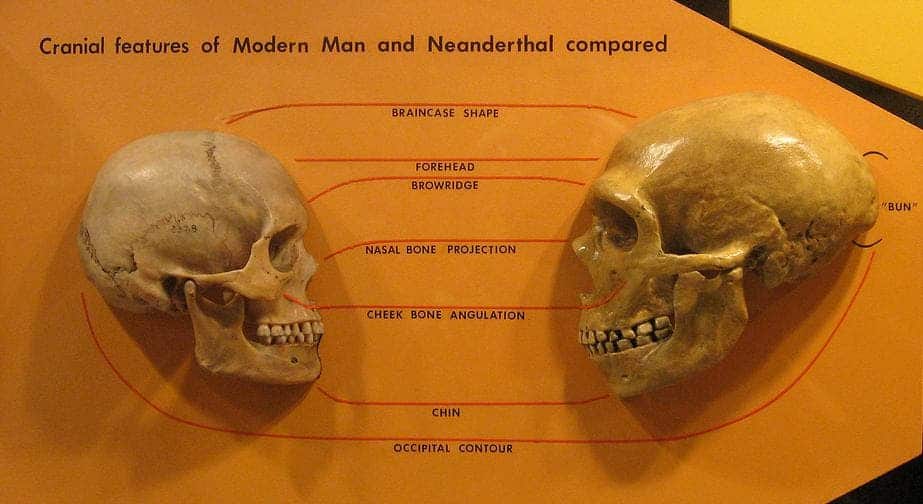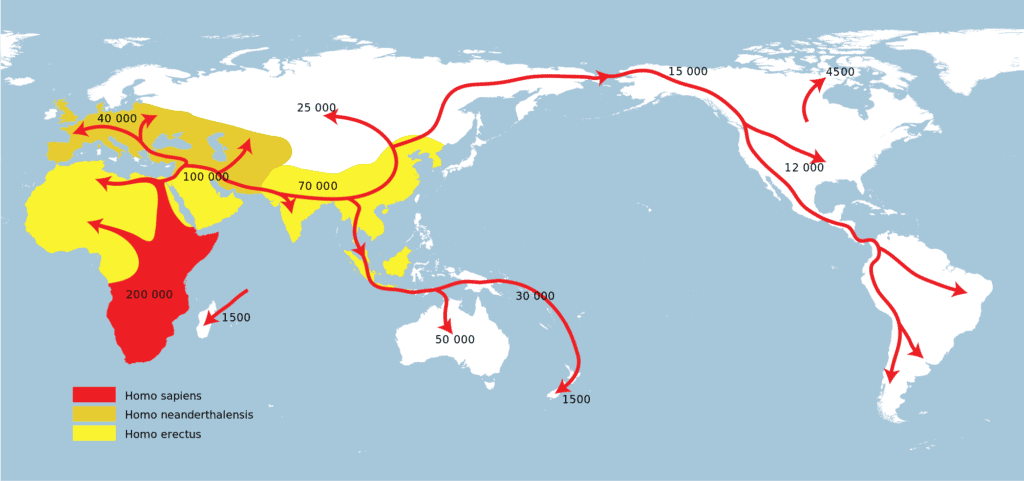Wither Neanderthal?
"It's like everyone is searching for 'just so' stories about why one species led the other to extinction."
"It's the simplest model that we can build without assuming any hard-to-prove claims, like selection or environmental change."
"What do I expect would have happened by default?"
"...Even if there were no selection and no climate change, the end result would have been the same."
Oren Kolodny, evolutionary biologist, Stanford University
 |
| Not that different, right? Comparison of Neanderthal and Modern human skulls from the Cleveland Museum of Natural History -- ZMEScience |
No, they don't look all that different, really. The skull of Neanderthal is bulkier than that of Homo Sapiens. Evolutionary biologists a long time ago postulated that Neanderthal women could carry a Homo Sapiens to birth, but a Homo Sapiens woman could not carry a Neanderthal fetus to live birth; her birth canal simply would be unable to accommodate the larger skull. But that the current human community has traces of Neanderthal DNA appears to have been well established, so Neanderthal as a species has left its mark for posterity on humanity.
"People of Caucasian descent have, within their genomes, small amounts of Neanderthal DNA. Previous studies have shown this ancient DNA may influence a person’s health, but a new study in the American Journal of Human Genetics today (October 5) reveals that the effects of one’s inner Neanderthal are even more wide-reaching."
"'[This study] is looking at a huge cohort and at a different set of traits than have been directly analyzed before, many of which are nonmedical,' says evolutionary and computational geneticist Tony Capra of Vanderbilt University who was not involved in the current study but performed a similar analysis of Neanderthal-influenced medical traits last year 'And what’s really exciting is that even though there was this broader scope of traits that was considered, they point to effects of Neanderthal DNA on similar systems to what’s been seen previously'."
"After the 2013 discovery that Neanderthals interbred with the ancestors of modern Europeans, says Janet Kelso of the Max Planck Institute for Evolutionary Anthropology, “one of the questions that came up was what effect does that have on the genomes of people today, what effect does it have on their phenotypes'?"
Ruth Williams, October 5, 2017, The Scientist
 |
| In this file photo, visitors take pictures of models representing Flores, human and Neanderthal women in the “Musee des Confluences”, a new science and anthropology museum in Lyon, central France. Neanderthals had a long run in Europe and Asia, but they disappeared about 40,000 years ago after modern humans showed up from Africa. |
Neanderthals have been proven by paleolithic research to have been far more industrious and intelligent than they were believed to have been with the revelations that Homo neanderthalensis who migrated across Europe and Asia for over 300,000 years were capable of producing tools and even art and jewellery. They predated modern humans and as precursors of what we like to think of as 'man the wise' (Homo Sapiens Sapiens), accomplished, it would seem, just as much as their successors did in manipulating their environment.
That mystery appeared to be solved; the understanding that Neanderthals were not the dumb brutes they were commonly held to be, but the mystery surrounding their eventual disappearance has not. Scientists still grapple with what it might have been that led to their extinction. Were they perhaps genetically predisposed to being more lethally vulnerable to disease? During one of nature's episodes of extreme climate change were they incapable of adapting? Was there a challenge with the appearance of modern humans that Neanderthals were unable to match, leading to their downfall?
A new paper out of Stanford University published in the journal Nature Communications, authored by Oren Kolodny and his colleague Marc Feldman posit a fairly basic hypothesis, that the Neanderthal extinction was caused through an happenstance intersection between bad timing and population dynamics. They expired, modern humans thrived. They emerged in Europe some 400,000 years ago and were eventually joined by anatomically modern humans. H. neanderthalensis and H. sapiens appeared to share the landscape of Europe for a period estimated between 51,000 and 39,000 years ago.
There was interbreeding between the species and likely survivalist challenges for territory. Over the millennia and having shared geography, the end result was the continuation of the Homo Sapiens line and the extinction of the Neanderthals. A design of nature, not inconsequential, but the result of various circumstances that have seen countless extinctions of various creatures on Earth throughout the ages. The researchers designed their model using known issues of ancient hominin population groups, migration patterns and ecological patterns.
Drs. Kolodny and Feldman constructed a computer model to simulate interactions in Paleolithic Europe. Europe, in the hypothetical simulation inhabited by bands of Neanderthals randomly shifting about and eventually dying. Occasionally a band of modern humans join the picture, themselves moving about with bands from each species sharing equal opportunities of displacing the other. The simulations were run a myriad of times with changing values to reflect variables matching uncertainties with this period in human history.
Despite a wide range of parameters the simulation models consistently demonstrated the die-out of Neanderthals within a 12,000-year period. The assumption being that Neanderthals were unable to match the slow and steady entry of human bands continually flowing north from Africa into Europe. The researchers hasten to caution that the result of their study does not really disprove humans had a selective advantage or that an episode of aggravating climate change influenced the situation. But they are confident that irrespective of both issues being present or absent, Neanderthal extinction would have occurred.
 |
| Migration of species, via Wikipedia. |
Labels: Bioscience, Evolution, Homo Sapiens, Nature, Neanderthal

0 Comments:
Post a Comment
<< Home